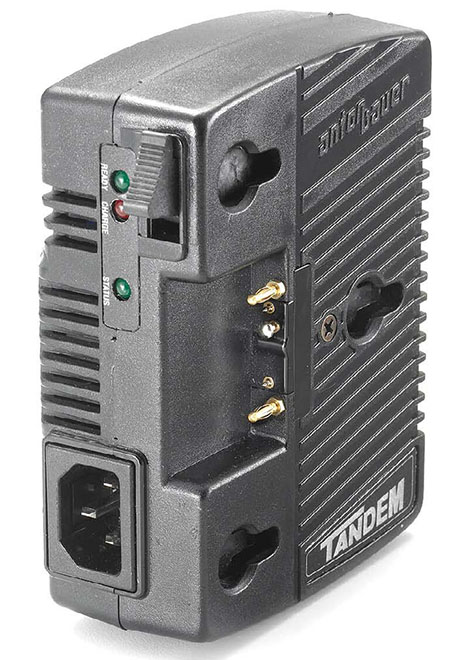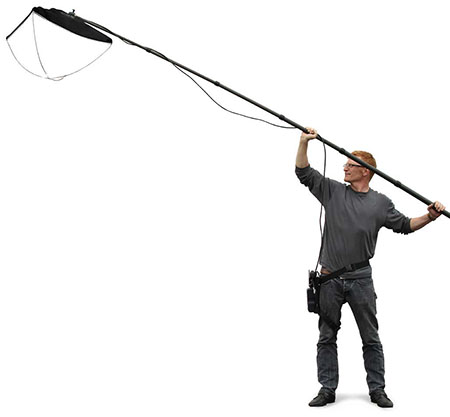Speed, Weight Drive News Gear Developments
SEATTLE—“I feel the need for speed,” touts one of the signature lines from the movie “Top Gun.” A TV news liveshot crew also feels the need for speed in getting a live-shot up and reporting.
Establishing pictures and sound and audio/video link back to the studio is just part of the challenge. There’s also getting camera support up, the talent lit and battery power up and running before the liveshot is ready for air. Equipment designers and manufactures have spent a lot of R&D building speed of deployment features into their products.

For its new flowtech 75, the Vitec Group repositioned all of the braking clamps to the top of the tripod allowing users to operate all tripod stages and brakes from the top of the tripod.
FAST & FLEXIBLE DEPLOYMENTS
A tripod is a must for most liveshots, where the field reporter may spend many minutes on camera, in split screens, answering questions from anchors back in the studio.
At the 2017 IBC Show, The Vitec Group plc launched flowtech 75, described by Global Product Marketing Director Tobias Keuthen as “a completely new tripod technology designed for extremely fast deployment.”
The company repositioned all of the braking clamps to the top of the flowtech 75, allowing the user to operate all tripod stages and brakes from the top of the tripod, according to Keuthen. “This makes it extremely fast to deploy and to adjust,” he said, noting that the company used feedback from a global focus group to determine that users didn’t want to bend down to operate the brake. This makes the flowtech 75 quick to set up, especially when encountering an uneven surface, such as stairs, where just a single leg can be lengthened. The new tripod is marketed under the Sachtler and Vinten brands.
Jose Larios, manager of sales and marketing at Libec Sales of America, notes that liveshots are often more than just deploying the gear once. In actual practice, there can be a series of deployments as news crew move ever closer to the middle of the action, as conditions allow. For these situations, Larios recommends Libec’s RSP-750MC, a carbon fiber tripod with a mid-level spreader that is easy to transport from one location to another with the camera still attached.
Get the TV Tech Newsletter
The professional video industry's #1 source for news, trends and product and tech information. Sign up below.
“Where most tripods have to collapse all the way when being carried, the 750MC is designed with rubber grips so you can basically carry it to another location, without having to pack it up and remove everything for a run-and-gun situation,” he said.
The Sprinter II tripod system from Miller solves the challenge of quickly setting up a tripod with its high speed, independent 2-stage dual leg locks. “The operator is basically going to stick his fingers into the locks, pull to release them, and lift the tripod up,” said Gus Harilaou, president of Miller Camera Support Americas. “This will deploy both the top and bottom sections with ease and quickness. Because of the dual lock, they don’t jam up, and the shooter can lock off and get his shot. If it’s something where they’re doing a sit down interview—where they’ll use just the top section of the tripod—they can just use the top lever to extend one section of the legs.”
For fast setups, Shotoku offers its SH100 tripod system. “The clamps are 180 degree turning, and they reach an end stop where they won’t collapse,” said Graham Ramsey, senior advisor at Shotoku Broadcast System. “That way you don’t have to keep tightening the clamping system to make sure you’ve got the tightest possible clamp. The way we set it up is to haul the system as a vertical unit when it comes out of the bag, untwist the three locks and let the legs drop, and then tighten the clasps one turn so that they’re fixed. Open the tripod and you’re ready to shoot. You can do that in a couple of seconds.”

Anton Bauer’s Tandem sits between the battery and the camera and powers the camera from mains, while charging the battery at the same time.
ILLUMINATING ADVICE
If the news crew could put the liveshot talent anywhere they wanted, lighting during the day might not be so important. But live-shot stand-ups are usually staged so the most visually interesting scene is over the reporter’s shoulder, no matter what kind of facial shadows that creates. So quick-deploying lights are a must.
This is a direction Litepanels has been moving toward, according to Alan Ipakchian, product marketing manager. “We’re steering a lot of our effort to maintain the lightweight form factor that will allow the light to be powered from battery.” The company recently introduced its Gemini 2x1 panel softlight, capable of accurate, agile full spectrum daylight and tungsten lighting as well as any color off the color wheel.
Battery-powered operation is crucial because it eliminates the amount of time consumed to run AC cabling, according to Ipakchian. “When we’re running on an Anton Bauer-like Cine musical X battery, you get the full punch of the Gemini,” he said. “Some other lighting fixtures, when they’re running on a battery, reduce the fixture’s output by half.”
Some of the most dramatic breaking news live-shots are in extreme storm coverage. Trying to protect light fixtures in those conditions can be time-consuming, if not futile. “In the case of our StarMaker IP65 fixture, the very best thing about this fixture is it’s IP65, which means it’s weatherproof,” said Jose Maria Noriega C.A.S., CMO at Fluotec. “It can be used, for example, by the Weather Channel covering a hurricane. You can bring it to the desert in a sandstorm or to a tornado. It’s up to the abuse that these fixtures face out in the field.” That ruggedness does not take away from its soft illumination, tunable color temperature and ability to operate off batteries.

BB&S’s lightweight Flyer boom light can be flown out in front of the camera, supported by a boom pole held in place by a C-stand cradle.
Toby Sali of BB&S Lighting suggested a boom light, the Flyer, for fast live-shot setups. “Once people try the Flyer, they use it for everything,” he said. “It’s got a China ball for diffusion on the light, and if the weather’s bad you can put a white garbage bag over it.”
The lightweight Flyer can be flown out in front of the camera, supported by a boom pole held in place by a C-stand cradle. “With the mic cable strung inside the boom pole, you can even hang a mike along with the Flyer,” Sali added. “Power cable lets you run off a battery pack without putting the weight of the battery out by the light fixture.” The Flyer is color-agile from daylight to tungsten, and is dimmable and color tunable remotely.
Kevin Crawford, COO and vice president of engineering at Frezzi, recommended his company’s Skylight System for a run-and-gun live-shot crew. “In our Go Kit case you have the light, stand, battery pack, AC power supply, barn doors and filters,” he said. “It has everything they need to go, and it deploys in no time.”
Crawford pointed out that a fast-moving crew not only has to deploy lighting equipment quickly, but also to pack up quickly to move to a better vantage point or on to another story. “With tungsten fixtures you had to wait for them to cool down before packing them away,” he said. “And with HMIs you not only had to wait for them to cool down, but HMIs didn’t reach correct color until a minute or two after firing them up. LED lighting, with passive cooling like our Skylights, have made this a non-issue.”
For live-shots the go-to light from Cineo is the MAV X, a small, 8000 lumen fixture that’s “powerful and color tunable,” according to Cineo President Rich Pierceall. It can run off V-lock and A/B battery packs, AC adapter and even off the cigarette lighter receptacle. “At full power off a battery pack you can get an hour and a half of lighting,” he said.
The MAV X has color tuneability that goes from 2700K to 6500K, which means you can work under any ambient light setting and match to it. “And there’s enough output that you can battle the sun with it, while dimming is photo-accurate down to one percent,” Pierceall said. “The dimming presets are all set at camera f/stops, so as you change your lens aperture to affect depth of field, you can match the light level to it.”
POWERING IT ALL
Just about everything the news shooter uses, from lights, RF microphone transmitters and receivers, to lights and live-shot transmission gear, takes electricity. And hooking all those batteries up to all that equipment ultimately takes time.
News crews used to take a bag full of batteries that had been charged overnight and throughout the day the batteries would be used to power a variety of devices, according to Andrew Butler, strategic planning and projects manager of the Videocom division at Vitec Group. Anton Bauer developed a device called the “Tandem,” which sits between the battery and the camera, and when you have access to mains power, you plug an AC lead.
“The Tandem will power the camera from mains, and it will charge the battery at the same time,” Butler said. This saves time because even if AC power is available at the liveshot site, a battery pack can get things rolling for the first report.
Butler said Anton/Bauer will soon introduce battery and charger technology capable of cutting the charging time of a battery pack in half, without damage to the batteries. The battery packs should be available in early 2018, with the chargers available later in the year.
A live-shot news crew on the scene at one breaking news story can find itself being redeployed to another story before making a trip back to the studios to grab fresh battery packs. But when available battery packs run down, the crew can be out of business.
Frezzi’s Kevin Crawford said that’s where his company’s FLB-240 battery packs can save the day. “What we hear from the field is that our 240Wh battery is a two-day battery,” he said. “It used to be a battery would last only a couple of hours, but with this battery you’re getting two days of run time out if it. And with our gauge they can keep an eye on the status of the batteries.”
